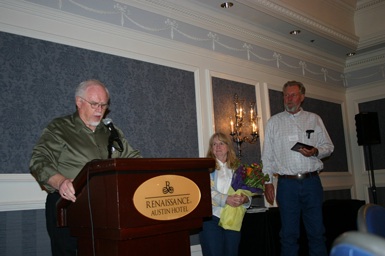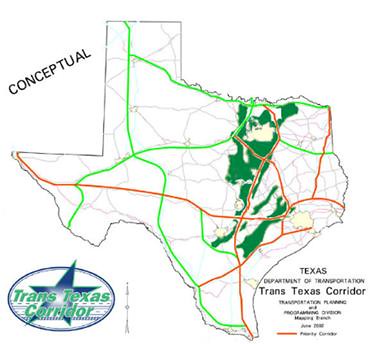The nature of sub-regional group debatedby Paul A. Romer
Temple Daily Telegram
HOLLAND -
A group of rural politicians from East Bell County that have banded together to fight the Trans-Texas Corridor look and act like a governmental body, but the state has yet to recognize it as such.In July 2007, the mayors of Holland, Little-River Academy, Bartlett and Rogers, with help from a special-interest group named Stewards of the Range, created an organization called the Eastern Central Texas Sub-regional Planning Commission. The sole purpose of the group is to quash the corridor, to make sure it doesn’t split up local farmland and school districts.The sub-regional commission held public meetings with state agencies such as TxDOT, Texas Commission on Environmental Quality and the Texas branch of the National Resources Conservation Service.By all appearances, the commission looks to be an acting governmental body.
Fred Kelly Grant, president of Stewards of the Range, said the group has followed the “letter of the law” in the way it was organized.Others point to the law, specifically chapter 391 of the Texas Local Government Code, as a reason the group should be considered “extra-governmental.”
“Chapter 391 allows regions and subregions to organize, but the governor must so designate,” said
Jim Reed, executive director of the Central Texas Council of Governments, which was created under chapter 391. “My understanding is the governor has not so designated. Whether they have legal standing under the state of Texas is under debate, although I don’t think anybody would debate that getting together to solve problems is a good thing.”
A spokeswoman for Gov. Rick Perry’s office would not comment about whether the subregional commission is recognized by the state. Eight more have been created in Texas over the past 18 months.Some government officials see the creation of these commissions as an attempt by a special-interest group to twist the law in their favor and introduce more bureaucracy into the planning process.
Since 1965, when Chapter 391 was created, 24 planning commissions have been created in Texas. These commissions, generally referred to as councils of government, encompass all counties in the state.
Bell County and six neighboring counties are tied to the Central Texas Council of Governments, with offices in Belton.
The idea that more commissions could be created using boundaries other than what has already been established is new.
“Why spend money and create another bureaucracy that does the same thing as the council of governments?” Reed asked. “For over 40 years CTCOG has been the vehicle chosen to speak regionally and we’re honored to play that role for all communities in the region, including those who have joined the subgroup.
“We happen to think our vehicle, being recognized by the government at both the state and federal level, is the advocacy vehicle that can receive good results for Texas … Our mission statement is accomplishing together that which we cannot accomplish alone.”
Reed admits the local council of governments has not spent much time on corridor issues that concern the rural subregional commission.The issue is not vital or as important to all seven counties, he said.The subregional commission argues that by banding together it has been able to find out more information and play a more significant role in the planning process than would have been possible through the council of governments.A planning organization from within the council called the Killeen-Temple Urban Transportation Study recently passed a measure that would give rural leaders in East Bell County a place at the table for planning area roadways.
An attempt to expand the jurisdiction of the transportation study is under way with one scenario calling for one member of a proposed 12-member board to represent the interests of East Bell County.Mae Smith, mayor of Holland, said the transportation study does a poor job of representing the interests of rural east Bell County, and she and her partners are not about to dissolve their board to join an organization where they might have less impact.Earlier this year, commissioners in Brewster County were invited to be members of a subregional commission being formed in its area. Before making a decision whether to join, the commissioners court consulted with
Austin attorney Greg Hudson.Hudson said he advised commissioners in Brewster County that they were well represented by the Rio Grande Council of Governments.
“Where did they find the authority to create a district smaller than what
the governor created?” Hudson asked about subregional planning commissions.
Then there is the question of how the subregionals pay for expenses. Hudson said he sees a real problem if a subregional commission uses taxpayer money.So far any spending of tax money by the local subregional commission appears marginal. A week ago, Holland taxpayers paid for lunch for the rural commission and Texas Commission on Environmental Quality officials after a two-hour meeting in Holland, Ms. Smith said.If a subregional commission were determined not to be what it purports to be, its members may not be afforded the legal protections extended to those who serve on a legitimate board or council. In other words, members may be opening themselves up to personal lawsuits.
“They may have a noble cause and have absolutely honorable intentions, but they may want to contact their local city attorney to make sure they have governmental protections,” Hudson said.Ms. Smith said Holland’s city attorney drew up the resolution form used to create the rural commission.“I can assure you we are legal,” she said. “If the state of Texas wants to go to court over this, we have documented everything and we are ready.”Penny Redington, executive director of the Texas Association of Regional Councils, said the rural commission here is “duplicative,” which was one of the issues the law to form the commissions was created to guard against.
“If they have succeeded in creating a commission, there are huge responsibilities such as annual audit requirements and open meetings requirements, to name just two. It’s a serious undertaking, not something you do on a lark, on a whim.”
© 2008 Temple Daily Telegram
www.tdtnews.com









